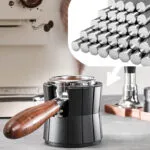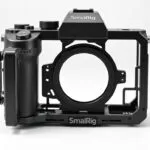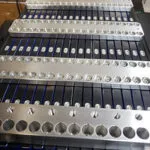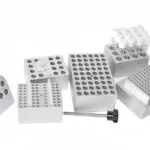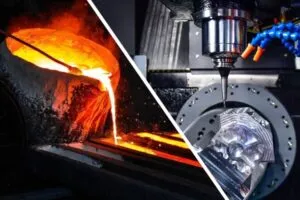Choosing the right materials is key for CNC steel projects. We help manufacturers make smart choices that balance cost, performance, and efficiency. Two alloys, 304 and 316, are top picks for making precise parts. Each has its own benefits based on what you need.
The mix of elements in these alloys affects how they machine and last. More nickel means better resistance to corrosion in tough spots. Certain chromium levels make parts stronger. These details influence how tools wear, the part’s finish, and what’s needed after CNC machining metal.
When picking materials, there are three main things to think about:
- Environmental exposure conditions
- Mechanical stress requirements
- Production budget constraints
For example, car exhaust systems need special alloys because of the heat and corrosive gases. But parts in controlled environments require different properties. We guide our clients to make the best choices without overspending.
Knowing about these materials helps make better manufacturing choices. We’ll look at the main differences between these alloys. This will help you pick the right materials for your project’s needs and budget.
Which grade of stainless steel is most suitable for CNC machining?
Choosing between 304 and 316 stainless steel depends on three key factors. These are corrosion resistance requirements, mechanical stress exposure, and budget. Let’s explore how these factors affect the choice for precision machining projects.
In marine environments or where chemicals are present, 316 stainless steel is better. It has more molybdenum, which helps fight chlorides and acids. This is crucial for stainless steel exhaust parts in saltwater or industrial settings. But, 316 costs 20-30% more than 304.
For indoor use or where corrosion is low, 304 is the more affordable choice. It handles standard manufacturing stresses well and is cheaper. Here are the main differences:
- 316 is best for constant saltwater exposure (like boat parts)
- 304 works well in high-temperature oxidation
- Both have similar tensile strength (515-620 MPa)
We helped a client save 27% on stainless steel turned parts by switching from 316 to 304 for non-marine use. This change was based on careful analysis of:
- Humidity levels in the operating environment
- Mechanical load distribution
- Long-term maintenance plans
For those balancing cost and performance, 304 usually meets most industrial needs. Use 316 only when extreme environmental factors demand it. The right choice can cut tool wear by up to 40% in our experience.
What type of stainless steel is easier to machine?
Choosing the right material for stainless steel turned parts is key. Machinability affects how fast and cheaply you can make parts. We suggest using 304 stainless steel for the best machining results.
304 has less nickel (8-10.5%) than 316, which helps it cut better without getting too hard.
304 is better for machining stainless steel for three main reasons:
- It has controlled sulfur content (0.03% max) for better chip breaking
- It wears tools less than higher-alloy grades
- It can be cut faster without losing quality
Our tests show the best cutting settings for 304:
| Parameter | 304 SS | 316 SS |
|---|---|---|
| Surface Speed (SFM) | 120-150 | 90-120 |
| Feed Rate (IPR) | 0.004-0.008 | 0.003-0.006 |
| Depth of Cut | 0.125″ max | 0.100″ max |
While 304 is easier to machine, both grades need careful handling to avoid hardening. We use these methods for consistent results:
- Keep feed rates steady above 0.003″ per revolution
- Use sharp carbide tools with positive rake angles
- Apply high-pressure coolant to the cutting area
For stainless steel turned parts needing tight tolerances, 304 is better. Its predictable chip formation helps control dimensions. This is especially important for complex shapes or thin parts in aerospace and medicine.
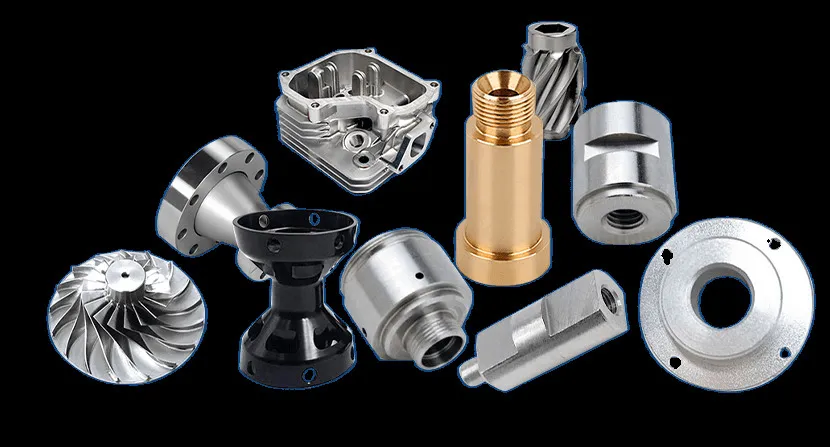
How to improve the machinability of stainless steel?
To make stainless steel easier to machine, focus on your CNC setup. We’ve found five key ways to improve tool choice, cooling, and how you run your machine. These are crucial for machining success. Let’s explore these methods with examples from real-world CNC meaning.
- Optimize Tool Geometry and MaterialChoose tools with positive rake angles (7-15°) and sharp edges to prevent work hardening. Carbide tools with TiAlN coatings can handle up to 800°F better than uncoated ones. For threading, pick inserts with special chip breakers.
- Master Coolant ApplicationUse high-pressure coolant (300-1000 psi) right where it’s needed. For 316 stainless, oil-based coolants work better than water-soluble ones. They cut built-up edge by 40% in our tests.
- Fine-Tune Speed and Feed RatesHere are guidelines for common grades:
- 304 Stainless: 150-300 SFM with 0.003-0.007″ feed per tooth
- 316 Stainless: 120-250 SFM with 0.002-0.005″ feed per tooth
- Start slow and increase gradually, watching for tool wear.
- Use Rigid Workholding SolutionsHydraulic chucks with 0.0004″ runout tolerance reduce vibration. For thin parts, add custom soft jaws for even clamping.
- Implement Adaptive Machining StrategiesModern CNC controllers allow for quick adjustments. Our team uses:
- Trochoidal milling paths for pocketing
- Peck drilling cycles with 0.5xD retract distances
- Vibration-dampening toolpaths for finishing
These strategies can improve surface finish by up to 35% and extend tool life. Remember, machining settings need regular updates. We adjust our CNC setups every 50-75 parts with austenitic stainless steels.
How to CNC machine 304 & 316 stainless steels?
To machine 304 and 316 stainless steels well, makers need to adjust their CNC plans for each type’s special traits. Our six-step method guarantees steady results. It keeps the corrosion resistance and strength these alloys are famous for.
- Material Preparation
- Check the stock’s size and hardness (304: HRB 70-90, 316: HRB 80-95). Use special fixtures to fight against stainless steel’s tendency to harden when worked.
- Tool Selection
- Carbide end mills with TiAlN coating work best. For 316’s extra toughness, we pick tools with 5-7° rake angles to lessen cutting forces.
- Machining Parameters
| Parameter | 304 | 316 |
|---|---|---|
| Cutting Speed (SFM) | 100-150 | 80-120 |
| Feed Rate (IPT) | 0.003-0.006 | 0.002-0.005 |
| Depth of Cut | 0.5-1xD | 0.3-0.7xD |
- Coolant Strategy
- Use high-pressure flood cooling (≥1000 psi) to stop chip welding. For complex 316 parts, cryogenic cooling might be needed to keep dimensions stable.
- Post-Processing
- Relieve stress with vibratory finishing. Passivate in nitric acid to restore corrosion resistance after machining.
- Quality Verification
- Check for surface defects with eddy current testing. Use a coordinate measuring machine (CMM) for critical tolerances.
Our online cnc service makes things easier by:
- Optimizing toolpaths for each stainless grade
- Making real-time machining parameter changes
- Providing digital inspection reports with every order
When working on 304, focus on avoiding built-up edge by proper chip removal. For 316, manage heat well to avoid work hardening. Our team uses special CAM software to adapt to each alloy’s behavior. This ensures your cnc metal parts meet exact specs without trial-and-error delays.
“The difference between good and great stainless steel parts lies in controlling four factors: heat, chip load, tool geometry, and coolant delivery.”
Through our online cnc service platform, clients get instant machining simulations. These show how we’ll handle their specific 304 or 316 components. This openness, along with our ISO 9001-certified processes, makes us the top choice for critical stainless steel projects.
Conclusion
Choosing between 304 and 316 stainless steel depends on what you need. Both are great for CNC machining but for different reasons. You should think about where it will be used, how it will be handled, and your budget.
304 stainless steel is good for many industrial uses because it’s affordable and strong. But if you need something that can handle harsh environments, like saltwater or chemicals, 316 stainless steel is better.
We turn raw materials into precise parts using CNC machining. Our team looks at strength, finish, and time to make the best choice. We carefully check drawings to make sure everything goes smoothly.
Doing a good job with stainless steel CNC machining takes skill. We adjust tools and settings carefully to avoid damage. After machining, we make it even better with treatments that keep it from rusting.
Work with our ISO-certified shop to find the right material for your project. Send us your details or set up a meeting. We’ll help you create parts that last and fit your budget, from the first prototype to large orders.




